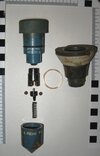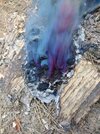pzgr40
Well-Known Member
Cutaway model of a C3A1 ‘Elsie’ mine. This peculiar mine is the only dug in anti-personel mine in the world using a shaped charge. The Elsie mine was designed by the Canadian army and produced by Canada. The mine was also used by the US army as the M25 and by Japan as the ‘Type 67’. The Elsie mine was manufactured in the colours olive green and sand yellow. On top of the mine body and the explosive charge a layer of felt is glued to camouflage the mine. The top of the explosive charge is not roud , but has an irregular shape to make it less obvious.
The Elsie mine is manually placed.
The C3 in the designation of the mine means the mine is non metallic.
The mine body is conical shaped, the explosive container with the shaped charge is placed in top of the mine body. This explosive container roughly has the size of the cork of a wine bottle. The pointed lower part of the mine body is screwed over the base of the upper mine body. The lower mine body houses the firing pin spring. The firing pin is placed on top of the -tensioned- firing pin spring. The firig pin has two opposite machined recesses in which a steel ball each is partially placed. The firing pin housing consisting of a ring with two recesses is placed around the firing pin, housing the rest of the two steel balls. The steel balls are kept in inward position by the hole in the upper mine body that is slightly bigger than the ring around the firing pin. The detonator housing is placed on top of the firing pin housing, kept in the lower position by a recess in the upper mine body. This allows for the explosive charge container to be removed, the mine body to be pushed in to the ground, and the explosives container to be replaced.
The Elsie mine is fully plastic made, the only non plastic parts are the firing pin spring, the two steel balls and the needle of the firing pin.
A removable aluminium ring is placed around the top of the upper body, allowing the mine to be either detectable or not.
If the mine is stepped upon the shaped charge container is pushed downward, pushing the detonator housing, the firing pin housing and the firing pin wih the steel balls downward, up till the moment that the two steel balls reach the wider part in the lower mine body, allowing them to move outward, releasing the spring loaded firing pin to move upward into the detonator (red). The exploding detonator will ignite the shaped charge.
The shaped charge points the force of the explosion upwards. If one steps on the mine with the front of the foot, a hole will be shot through the foot. If stepped upon with the heel, the entire length of the lower leg will be pierced.
The plastic lined shaped charge is able to penetrate a 9mm thick steel plate, in spite of not having a copper cone.
The Elsie mine is designed primarily to disable a person, rather than kill them.
The Elsie mine is fully plastic made, the only non plastic parts are the firing pin spring, the two steel balls and the needle of the firing pin.
Diameter : 51 mm
Length : 85 mm
Weight : 80 grams
Explosive charge C3A1 : 9 grams Tetryl
Explosive charge C3A2 : 9,45 grams Compositie A5 -(98.5% RDX mixed with 1.5% stearic acid)
Operating pressure : between 7,25 and 11,8 kg
Regards, DJH
The Elsie mine is manually placed.
The C3 in the designation of the mine means the mine is non metallic.
The mine body is conical shaped, the explosive container with the shaped charge is placed in top of the mine body. This explosive container roughly has the size of the cork of a wine bottle. The pointed lower part of the mine body is screwed over the base of the upper mine body. The lower mine body houses the firing pin spring. The firing pin is placed on top of the -tensioned- firing pin spring. The firig pin has two opposite machined recesses in which a steel ball each is partially placed. The firing pin housing consisting of a ring with two recesses is placed around the firing pin, housing the rest of the two steel balls. The steel balls are kept in inward position by the hole in the upper mine body that is slightly bigger than the ring around the firing pin. The detonator housing is placed on top of the firing pin housing, kept in the lower position by a recess in the upper mine body. This allows for the explosive charge container to be removed, the mine body to be pushed in to the ground, and the explosives container to be replaced.
The Elsie mine is fully plastic made, the only non plastic parts are the firing pin spring, the two steel balls and the needle of the firing pin.
A removable aluminium ring is placed around the top of the upper body, allowing the mine to be either detectable or not.
If the mine is stepped upon the shaped charge container is pushed downward, pushing the detonator housing, the firing pin housing and the firing pin wih the steel balls downward, up till the moment that the two steel balls reach the wider part in the lower mine body, allowing them to move outward, releasing the spring loaded firing pin to move upward into the detonator (red). The exploding detonator will ignite the shaped charge.
The shaped charge points the force of the explosion upwards. If one steps on the mine with the front of the foot, a hole will be shot through the foot. If stepped upon with the heel, the entire length of the lower leg will be pierced.
The plastic lined shaped charge is able to penetrate a 9mm thick steel plate, in spite of not having a copper cone.
The Elsie mine is designed primarily to disable a person, rather than kill them.
The Elsie mine is fully plastic made, the only non plastic parts are the firing pin spring, the two steel balls and the needle of the firing pin.
Diameter : 51 mm
Length : 85 mm
Weight : 80 grams
Explosive charge C3A1 : 9 grams Tetryl
Explosive charge C3A2 : 9,45 grams Compositie A5 -(98.5% RDX mixed with 1.5% stearic acid)
Operating pressure : between 7,25 and 11,8 kg
Regards, DJH
Attachments
Last edited:











